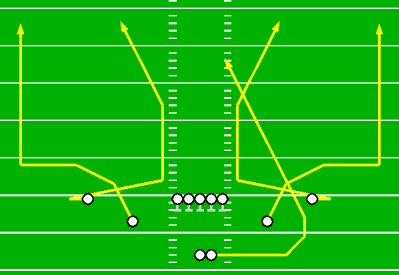Description
Maybe my most sophisticated play created to date, Flicker seeks to use every bit of the field and give the quarterback multiple reads for nearly every receiver. Flicker was heavily influenced by both the undercutting routes of Undercuts and the snapback routes of Reflex. The wide receivers start out running sideways across the field, then turn upfield in well defined routes rather than simply scrambling to find an open area. These multiple level routes give Flicker more depth than any other play.

Although Flicker has great depth, the main emphasis is on quick, sharp execution. The primary targets are the split ends, who can expect to gain anywhere from 3-10 yards, depending on how tight the coverage is and how early the throw comes, with a chance to turn upfield and run a lot farther if the safeties and linebackers are cleared out by the flanker out routes. The throws to the SEs require some zip as well as a good passing lane as they run right behind the defensive line. The flanker out patterns are the next best targets. These routes can expect slightly better yardage (about 5-10 on average), but with less chance for run after the catch and possible problems catching the ball in bounds. This throw requires a lot of touch, both a nice arc on the ball to get it over the CB covering the SE and placement to the outside, away from flanker's defender. Practice is crucial for all of these routes. To round things out the running back runs a type of swing that slants back into the middle of the field.
That covers the primary reads, but Flicker still has more to offer. Each route discussed so far primarily works sideways, stretching the defense laterally. Most of the time this works well enough to get a quick throw off for short to medium yardage. On the rare situations that the defense both crowds the short zone and does not bring much pressure, each receiver breaks into a completely new pattern down field. The SEs run side by side right up the seams before flaring slightly towards the corners, while the flankers turn and run up the sidelines. A dime or quarter defense may have stopped a relatively short passing attack only to be faced with a now greater downfield threat. These secondary routes are fairly simple, and against aggressive defenses will probably never be used, but can force the defense to run and cover farther than just about any other play.
Player Assignments
| Position | Action |
|---|---|
| O-Line | Pass Block |
| QB | Receive Shotgun Snap |
| RB | E4-N1E1-N1-N8W4 (open) |
| Left SE | W1-N1E5-N4-N4W2 (open) |
| Left Flanker | N2W1-N1W2-W3-N7 (open) |
| Right Flanker | N2E1-N1E2-E3-N7 (open) |
| Right SE | E1-N1W5-N4-N4E2 (open) |
See the Madden Playbook Guide for a description of these symbols.
Read Progression
- Right SE in
- Left SE in
- Left flanker out
- Right flanker out
- RB swing
- Right SE seam/corner
- Left SE seam/corner
- Left flanker sideline streak
- Right flanker sideline streak
As this is the most complex read progression in my entire playbook, it deserves some explanation. Except for the RB, the routes in this play are symmetric. The progression described is intended to allow the QB to scan back and forth, starting on the right so that the three right side reads that happen with the closest timing (right flanker out, RB, right SE seam) are in sequential order.
In practice most of these reads will never be made, as they simply take too long to develop, especially with the lack of blocking support. The first four reads are primary and all happen quite quickly, so it is most important to make a good evaluation of the defense before the snap and adjust the progression of these initial reads accordingly. The key areas are just a few yards past the line of scrimmage just outside of the tackles, where the SEs will make their catches. If the defense shows blitz, it may seem like the area where the blitzer comes for would be a good place to throw to. However, I have found in practice that often a LB will float out into zone coverage in this area, and the best target is actually the side which looks best covered before the snap.
Another thing to evaluate is whether the defense is playing man or zone on the outside. The flanker out routes seem to work best against man defenses, where the DB will have to turn his back to the QB to chase the receiver. The SE ins work fairly well against man defense but can slice across zones with ease. Just watch out for lurking LBs.
Analysis
Pros:
- Greater depth of reads than any other play
- Four quick routes designed to pick up easy short yardage with great opportunity to run after the catch
- Spreads the defense across as much of the field as possible
Cons:
- Very complicated play that requires precise timing and decisive execution, meaning lots of practice to be effective
- Primary SE in routes have a tendency to get tipped by defensive linemen if the QB does not pick a good passing lane
- Semi-vulnerable to bad shotgun snaps, mainly by screwing up quick throws to the SE in routes
- Flanker routes run all the way out to the sidelines, may have trouble staying in bounds on short side of field
Contact Arkaein with any comments or questions regarding the Monstrous Madden Playbook.